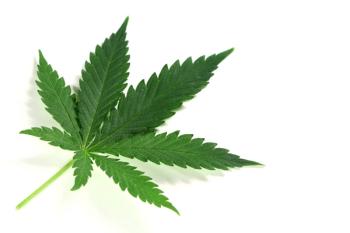
Cannabis Science and Technology
- June 2022
- Volume 5
- Issue 5
- Pages: 30-34
The Chiral Separation of the (+) and (-) Enantiomers of Cannabidiol
This article investigates the chiral method development screening for the enantiomeric separation of synthetic CBD on polysaccharide-based chiral stationary phases with both normal-phase and reversed phase mobile phases, using HPLC and UHPLC.
With the continued increase in the demand for cannabis-based products, extraction of cannabinoids from plant-derived materials might not remain a feasible route into the future. Synthetic routes for cannabinoid production have been developed to assist with specific needs that arise based on demand, and will certainly be developed into the future as new needs arrive. Given the specificity by which living organisms synthesize compounds, special care needs to be given when developing these synthetic processes to ensure proper stereochemical control. This ensures the formation of undesired or unexpected isomers of the intended target is avoided. This publication investigates the chiral method development screening for the enantiomeric separation of synthetic cannabidiol (CBD) on polysaccharide-based chiral stationary phases with both normal-phase and reversed-phase mobile phases, using high performance liquid chromatography (HPLC) and ultrahigh pressure liquid chromatography (UHPLC). Several new chiral separations of CBD enantiomers on CHIRALPAK IA, ID, IE, and IG are reported, with additional focus given to the use of longer columns, or the conversion from gradient to isocratic methods, to achieve complete baseline resolution of the enantiomers.
Plants and other living organisms are capable of synthesizing countless numbers of compounds required for said organism’s biological pathways. Because of downstream requirements for transformation or uptake, these compounds are often produced as a single enantiomer. That is a compound that has two configurations that are nonsuperimposable mirror images, resulting from an atom with a tetrahedral geometry (a chiral center) that has four different chemical entities bonded to it. Cannabis is such an example—it contains a complex mixture of major and minor cannabinoids, as well as terpenes and other plant-based compounds. Most of these compounds contain a chiral center, but are only found as a single enantiomer. A notable exception is cannabichromene (CBC), which has been documented as a mixture of both (+) and (-) enantiomers (1).
With continuing increase in the demand for cannabis-based products, lab-based synthetic routes can be developed to help alleviate potential supply bottlenecks, was well as provide access to the non-naturally occurring enantiomers and derivatives for clinical study or commercialization. For the synthesis of naturally occurring cannabinoids, or any cannabis-based product intended for human consumption, it is not a stretch to assume that at some point chiral testing could be required by a governing body, much like the US Food and Drug Administration’s (FDA) current requirements for pharmaceuticals testing (2).
The example presented in this publication is CBD. While cannabis synthesizes only the (-)-CBD enantiomer (3), synthetic routes have been reported to generate the non-naturally occurring (+)-CBD enantiomer (4). At present, the function of (+)-CBD is not fully established; however, it has been shown that it binds with a higher affinity to the CB1 and CB2 cannabinoid receptors than the naturally occurring (-)-CBD (4).
This publication explores the chiral separation of (+) and (-) enantiomers of CBD on polysaccharide-based chiral stationary phases, with normal-phase and reversed-phase mobile phases with high performance liquid chromatography (HPLC) and ultrahigh pressure liquid chromatography (UHPLC), with the goal of identifying baseline separations for the accurate quantification. Similar separations under reversed-phase conditions were reported previously (5), however this work improves on those methods by simplification of the mobile phase, and the use of a smaller particle size to significantly improve the analysis time.
Experimental
Samples of synthetic (+) CBD and (-) CBD were generously provided by KinetoChem, LLC. For normal-phase screening, each enantiomer was prepared separately as 2 mg/mL solutions in ethanol, and mixed in a 1:1 ratio. The columns screened included CHIRALPAK® IA-3, IB N-3, IC-3, ID-3, IE-3, IF-3, IG-3, IH-3, IJ-3, and IK-5 (150 mm L x 4.6 mm i.d.). For reversed-phase screening, each enantiomer was prepared separately as either a 1.2 mg/mL solution in MeOH (+ CBD) or 2.2 mg/mL in MeOH (-CBD), and mixed in a 1:1 ratio. The columns screened included CHIRALPAK® IA-5, IB N-5, IC-5, ID-5, IE-5, IF-5, IG-5, IH-5, IJ-5, and IK-5 (150 mm L x 4.6 mm i.d.). Solvents were purchased from Pharmco, were HPLC-grade or higher, and were used as-is. The hexanes (Hex) used contained 95% n-hexane, and the ethanol (EtOH) was reagent alcohol (90% EtOH denatured with 5% methanol [MeOH] and 5% 2-propanol [IPA] v/v/v). HPLC screening and optimization was performed on an Agilent 1200 equipped with a quaternary mixing pump utilizing a diode array detector (DAD). UHPLC optimization was performed on an Agilent 1290 equipped with a quaternary mixing pump, and a DAD.
Results and Discussion
Normal-Phase Chromatography
The individual enantiomers of CBD were mixed in a 1:1 ratio (as described earlier) and screened for chiral separation under normal-phase conditions using solvent mixtures Hex-EtOH = 95:5 (v/v) and Hex-IPA = 95:5 (v/v), on all available immobilized polysaccharide columns offered by Daicel. These starting conditions (95:5) provided for good retention on most columns. The initial screening resulted in a number of baseline or near baseline separations on most columns in the screening. Four columns, IA-3, ID-3, IE-3, and IG-3, all of a 3 µm particle size, yielded baseline or greater than baseline resolution. In all cases, the non-naturally occurring (+) CBD eluted first, with the naturally occurring (-) CBD eluting second.
Because applications can vary widely from user-to-user, the conditions provided in this work should be considered a starting point for further application-specific optimization. For this reason, performance specifications (retention factor [k’], selectivity [α], or resolution [Rs] for instance) are not provided, as they will be different after end-user optimization. The goal therefore was to establish conditions that provided for a complete baseline resolution. The chromatographic conditions used to generate Figures 2–7 are listed in Table I for reference, and are discussed further below.
The enantiomers of CBD were well resolved on IA-3 with both Hex-EtOH and Hex-IPA mobile phases (Figures 2 and 3). The separation was further improved from the initial screening by increasing the column length from 150 mm to 250 mm. This resulted in a greater than baseline separation of the enatiomers. Baseline resolution on ID-3 with Hex-IPA (Figure 4) was achieved on a shorter 150 mm length column by increasing the retention of the CBD enantiomers. This was accomplished by decreasing the elution strength of the mobile phase from Hex-IPA = 95:5 (v/v) to Hex-IPA = 97:3 (v/v). A longer column could likely also have been used with the original mobile phase conditions to achieve a similar result. The separation on IE-3 (Figure 5) was achieved using Hex-IPA = 95:5 (v/v) and a longer 250 mm length column. Finally, IG-3 (Figures 6 and 7) also provided good separation using both Hex-EtOH and Hex-IPA = 95:5 (v/v) mobile phases, on a longer 250 mm length column.
Given the large degree of separation that was achieved on the 3 µm particle size of IG (IG-3), the separation was also checked on a UHPLC instrument utilizing the sub-2-µm (1.6 µm) particle size equivalent, CHIRALPAK® IG-U. Smaller particle sized columns can be utilized at higher equivalent flow rates compared to their larger particle size analogs, without as noticeable of a drop in column efficiency. This arises from the reduced influence of the resistance to mass transfer, or C-term, of the Van Deemter equation. Because analytes are capable of interacting and departing from a small particle more efficiently than a large particle, the linear velocity (flow rate) of the mobile phase can be increased with less of a deleterious effect on resolution or selectivity (6). Plotting the Van Deemter equation visually demonstrates the relationship between theoretical plate height and linear velocity, where the relative minimum of the curve is the theoretical optimal flow rate to achieve the greatest column efficiency (Figure 8). There are a few factors that affect the overall appearance of the curve, one being the packing efficiency of smaller particles. Because sub-2-µm particles pack more efficiently compared to 3- and 5-µm particles, the overall theoretical plate height (H) is intrinsically lower. As shown in Figure 8, an increase in the linear velocity moving left to right produces an upward sloping curve, indicating a loss of efficiency as the theoretical plate height increases. However for the blue trace (sub-2-µm), the slope is not as steep as the red and green traces (3 µm and 5 µm, respectively), indicating less of loss of column efficiency (for sub-2-µm). It should be noted that to maximize the benefits of a sub-2-µm particle size, a UHPLC should be used. UHPLC systems are optimized to reduce extra-column dead volume from excess tubing, unnecessarily large inner diameter tubing, and large flow cell volume, which will reduce the efficiency of any column, put specifically columns with a smaller particle size. UHPLCs are also capable of achieving higher operating pressures compared to standard HPLCs, meaning faster flow rates for increased analysis speed. Under the mobile phase conditions of Hex-EtOH = 95:5 (v/v), the flow rate on an IG-U 50 mm length by 3.0 mm inner diameter column was increased from 1.0 mL/min to 3.5 mL/min, which resulted in the separation of (+) and (-) CBD in under 15 s (Figure 9). As the selector for IG-U is the same as IG-3 (only the particle size is different), the elution order is the same as in Figure 6. This ultra-fast analysis would allow for a rapid check of multiple batches of material in only a few minutes, saving significant time for quality control (QC) and quality assurance (QA) release testing.
Reversed-Phase Chromatography
Sample preparation for reversed-phase screening was slightly different from normal phase. The enantiomers were prepared separately in MeOH (as described above), and mixed in a 2:1 ratio. The 2:1 ratio was chosen simply to better visualize any elution order reversal from what was seen under normal phase conditions. A reversal of elution order can be an important handle to optimize a separation. For analytical applications, it is often preferred to have a low-level impurity elute in front of the main peak to achieve a better limit-of-detection (LOD) or limit-of-quantification (LOQ), as this avoids the possibility that the main peak will tail into the impurity, negatively affecting the ability to detect, and integrate it. However, for a preparative application, the main peak or enantiomer of interest should elute first to achieve a higher chiral purity.
The 2:1 mixture was screened under reversed-phase conditions using a gradient of 34 min, rather than performing a retention check as was done for normal phase. The gradient started at 90% water and decreased to 10% water over 20 min, followed by a 6 min hold at 10% water, and a final 8 min re-equilibration at 90% water. Given the higher viscosity of aqueous mobile phases relative to normal phase alkane–alcohol mobile phases, 5 µm particle size columns were used for this screening (rather than 3 µm particle size). From this screening, baseline separations were observed on CHIRALPAK® IA and IG (5 µm), as well as several partial separations on other columns.
Similar to the normal phase applications, the methods described for reversed-phase should not be considered optimized. The goal was again to achieve a complete baseline resolution. To improve the rate of sample analysis (34 min might be considered too long for some applications), the initial gradient method was converted to as isocratic method. This resulted in a significant time savings, nearly 30 min for the separation on IG. Although polysaccharide-based columns can be used under gradient mode, for repeated analyses, an isocratic method can be preferred as it does not require column re-equilibration after each run. The final chromatographic conditions used to generate Figures 10 and 11 are listed in Table II for reference, and are discussed further below.
From the initial gradient, isocratic conditions of Water-ACN = 45:55 (v/v) resulted in a baseline resolution of the CBD enantiomers on IA (Figure 10). Although IG had a shorter retention compared to IA, it showed a greater selectivity. Because of this, a higher percentage of organic solvent (ACN) was used to elute the enantiomers from the column faster, decreasing the analysis time. After conversion from gradient to isocratic conditions, Water-ACN = 30:70 (v/v) was found to maintain a greater than baseline resolution (Figure 11). In both cases, no reversal of elution order was observed from the respective normal phase conditions.
Similar to the normal phase separation in IG-3, the resolution on IG under reversed phase conditions was also sufficiently resolved to merit checking under UHPLC conditions. With a mobile phase of water-ACN = 30:70 (v/v), the flow rate on an IG-U 50 mm length by 3.0 mm inner diameter column was increased to 2.5 mL/min., resulting in a sub-20 second separation (Figure 12). Again since the selector of IG-U is the same as IG (5 µm), the elution order is the same as in Figure 11.
Conclusions
This publication presents several new normal-phase and reversed-phase HPLC and UHPLC methods for the chiral separation of (+) and (-) CBD. Multiple columns and mobile phase conditions provide flexibility for users to choose conditions that best suit their laboratory or company needs. The reversed-phase methods have the added benefit of being mass spectrometer (MS) compatible should this be a requirement or need for a particular application. The added separations on Chiralpak IG-U provide conditions for rapid sample analysis, which would help conserve a considerable amount of time should these methods be implemented for high-volume testing.
Disclaimer
As a responsible provider of quality products and services, Daicel Chiral Technologies makes available analytical techniques that may be of use to a broad range of customers and applications. It does not however support or promote the use of its products or services in connection with any contraband activities or products related to cannabis, including but not limited to illegal or illicit drug manufacturing, testing, or consumption.
References
- L.O. Hanuš, S.M. Meyer, E. Muñoz, and et al., Nat. Prod. Rep.33(12), 1357-1392 (2016).
https://www.fda.gov/regulatory-information/search-fda-guidance-documents/development-new-stereoisomeric-drugs .- E. Chesney, P. McGuire, T.P. Freeman, J, Strang, and A. Englund, Therap. Adv. In Psychopharmacology 10, 1-13 (2020).
- P. Morales, P.H. Reggio, and N. Jagerovic, Front. Pharmacol.8(422), 1-18 (2017).
https://phenomenex.blob.core.windows.net/documents/ebc0739a-ed1b-4225-82d5-f4538e442ebb.pdf .https://www.restek.com/en/technical-literature-library/articles/how-do-small-particle-size-columns-increase-sample-throughput/ .
About the Author
WESTON J. UMSTEAD, PhD, is the Technology and Business Development Manager at Chiral Technologies, Inc., in West Chester, PA. Direct correspondence to:
How to Cite this Article:
W. Umstead, Cannabis Science and Technology® Vol. 5(5), 30-34 (2022).
Articles in this issue
over 3 years ago
June 2022 Digital Editionover 3 years ago
Quantitative Spectroscopy: Practicalities and Pitfalls, Part Iover 3 years ago
What’s in a Vape? Part IINewsletter
Unlock the latest breakthroughs in cannabis science—subscribe now to get expert insights, research, and industry updates delivered to your inbox.




